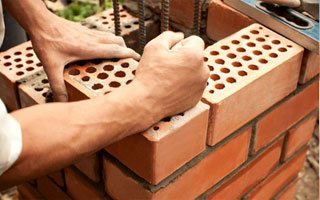Unlocking the Keys of Lasting Stonework Building Practices for Eco-Friendly Structures
In the world of modern-day building and construction, the quest of sustainable techniques has actually become paramount. Among the myriad techniques to eco-friendly building, sustainable stonework construction sticks out as a tried and true and long lasting approach that holds a wealth of untapped potential. From the selection of products to ingenious building strategies, the tricks to accomplishing sustainability within stonework construction are complex and intriguing. By checking out the benefits, products, strategies, and future fads of lasting stonework, a deeper understanding of exactly how these practices can form the future of eco-friendly buildings arises.
Advantages of Sustainable Masonry Building And Construction
Welcoming sustainable masonry building techniques not just lowers ecological influence however additionally supplies long-term economic benefits to contractors and areas. By utilizing products like recycled bricks, blocks, and stones, home builders can considerably decrease the carbon footprint of their projects while advertising source effectiveness. In addition, lasting stonework building strategies, such as correct insulation and thermal mass residential or commercial properties, can enhance energy effectiveness within structures, bring about minimized operational expenses over time.
Moreover, the resilience and durability of masonry frameworks contribute to lasting economic benefits. Buildings created using lasting masonry practices frequently call for less maintenance and repair, translating to set you back financial savings for builders and homeowner. The longevity of masonry materials likewise makes sure that frameworks stay stable and secure, lowering the need for constant improvements or replacements.
Eco-Friendly Masonry Products
Using environmentally friendly stonework products is a crucial action in the direction of improving the sustainability of construction practices and decreasing ecological effect while optimizing long-term financial advantages. Lasting masonry materials are sourced, created, and made use of in a way that reduces overall environmental effect. Products such as recycled blocks, recovered stone, and lasting cinder block are coming to be progressively prominent selections for eco-conscious building contractors. Recycled blocks, for instance, not only draw away waste from land fills however also require less energy to create compared to brand-new bricks. Redeemed stone uses an one-of-a-kind aesthetic allure while lowering the demand for new quarrying. Lasting concrete blocks incorporate recycled aggregates and may include improved insulation homes, adding to energy effectiveness in buildings.
In addition, natural products like adobe, rammed earth, and straw bales offer excellent thermal mass residential properties, minimizing the need for home heating and cooling energy. These materials are typically locally offered, promoting local economies and minimizing transportation-related carbon emissions. By choosing eco-friendly masonry products, construction projects can substantially reduce their ecological impact and contribute to the development of much healthier, a lot more lasting constructed environments.
Energy-Efficient Stonework Strategies
Power effectiveness plays an essential role in improving the sustainability of stonework building and construction techniques. By applying energy-efficient masonry techniques, contractors can considerably reduce the overall energy intake of a building, leading to lower operational costs and a smaller sized environmental footprint. One essential energy-efficient stonework method is using thermal mass, which entails including dense products like concrete or block right into the structure's structure to absorb and save warm. This aids manage interior temperature levels, lowering the need for mechanical home heating and cooling systems.

Advancements in Sustainable Stonework
Recent developments in lasting masonry practices have produced innovative techniques that are reshaping the construction market. One such technology is the growth of self-healing concrete, which utilizes bacteria installed within the concrete behr decorative concrete finishes to heal cracks autonomously. This innovation not just reduces upkeep expenses but likewise boosts the toughness of stonework structures, adding to their sustainability.
An additional significant development is making use of recycled aggregates in masonry construction - masonry contractor. By integrating materials such as smashed ceramic waste or recycled glass into concrete mixes, contractors can lower the ecological effect of building and construction projects while preserving architectural integrity. This technique not just draws away waste from landfills but likewise preserves natural deposits, making it an essential innovation in lasting masonry building and construction
Furthermore, the assimilation of digital design tools, such as Building Info Modeling (BIM), is revolutionizing click here for more the way masonry frameworks are intended and created. BIM enables more accurate estimations, decreased material wastefulness, and enhanced power effectiveness, inevitably leading to more lasting structure practices. These advancements collectively symbolize an appealing future for sustainable masonry building and construction in the age of eco-friendly structures.
Future Trends in Stonework Sustainability
With the ingenious strides made in lasting masonry techniques, the future fads in stonework sustainability are positioned to further reinvent the building market. One of the vital fads shaping the future of stonework sustainability is the increased assimilation of modern technology. Developments such as Building Information Modeling (BIM) and virtual truth simulations are being used to enhance masonry building processes, resulting in reduced material waste and enhanced energy efficiency in buildings.
Furthermore, the growth of novel lasting materials is readied to play a considerable function in improving the eco-friendliness of stonework construction. masonry contractor. Technologies like self-healing concrete, recycled accumulations, and bio-based binders are acquiring traction for their capacity to lessen environmental impact while keeping architectural stability

Conclusion
Finally, lasting stonework construction techniques offer various advantages for environmentally friendly buildings. By utilizing eco-friendly products and energy-efficient techniques, masonry can add to a much more lasting built setting. Technologies in sustainable masonry are continuously being established to further you could try here enhance the environmental performance of buildings. Looking in the direction of the future, the fad of stonework sustainability is anticipated to expand, bring about more eco-friendly and energy-efficient construction methods in the years to come.